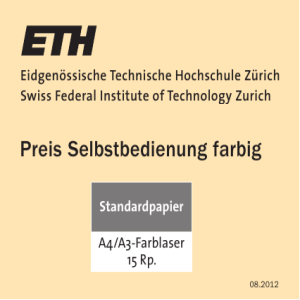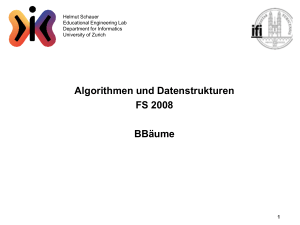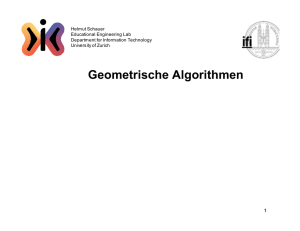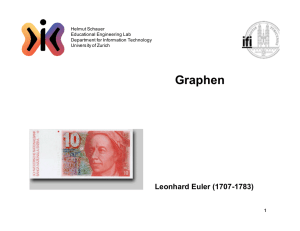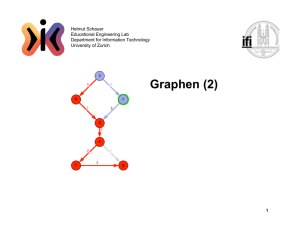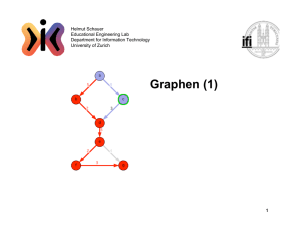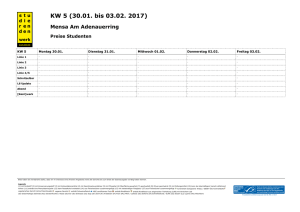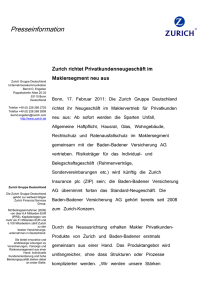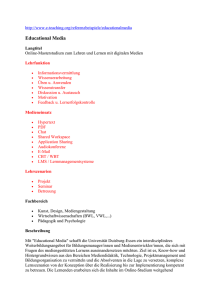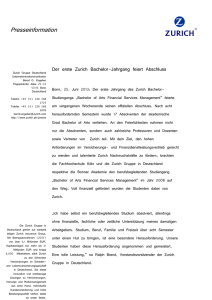PPT-Datei
Werbung
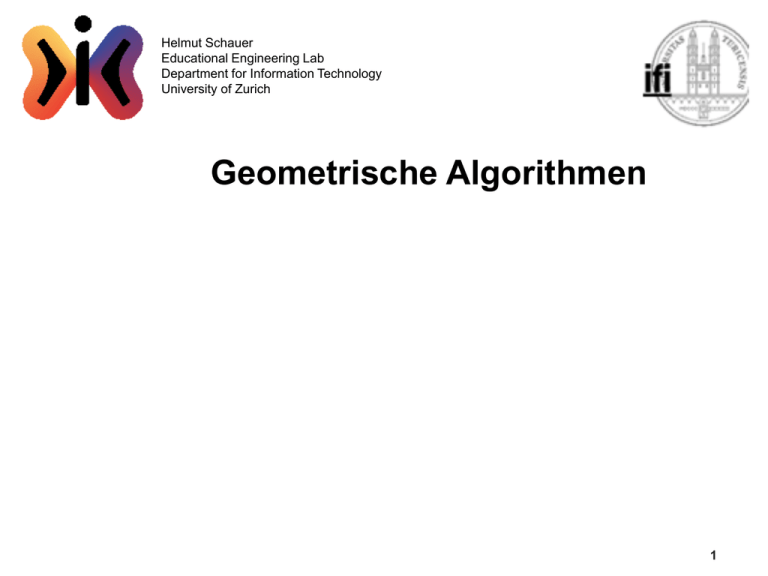
Helmut Schauer
Educational Engineering Lab
Department for Information Technology
University of Zurich
Geometrische Algorithmen
1
Helmut Schauer
Educational Engineering Lab
Department for Information Technology
University of Zurich
Beispiel:
Konvexe Hülle einer 2D-Punktmenge (1)
Die Konvexe Hülle ist ein konvexes Polygon mit minimalem
Umfang das sämtliche gegebenen Punkte einschliesst.
Punktmenge
Konvexe Hülle
2
Helmut Schauer
Educational Engineering Lab
Department for Information Technology
University of Zurich
Konvexe Hülle einer 2D-Punktmenge (2)
Graham-Scan O(N log N)
1)
2)
Bilde ein Polygon das die gegebenen Punkte ohne
Überschneidungen verbindet
Eliminiere sämtliche "einspringenden" Eckpunkte
Punktmenge
Polygon
Konvexe Hülle
3
Helmut Schauer
Educational Engineering Lab
Department for Information Technology
University of Zurich
Konvexe Hülle einer 2D-Punktmenge (3)
Polygon
Algorithmus zur Bildung eines Polygons:
1)
2)
Wähle einen Startpunkt (zB den untersten Punkt) und berechne
zu jedem weiteren Punkt den Winkel den die Verbindung dieses
Punktes und dem Startpunkt mit der Horizontalen einschliesst.
Verbinde die Punkte in steigender Reihenfolge dieser Winkel
Punktmenge
Polygon
4
Helmut Schauer
Educational Engineering Lab
Department for Information Technology
University of Zurich
Konvexe Hülle einer 2D-Punktmenge (4)
Eliminierung einspringender Eckpunkte
5
Helmut Schauer
Educational Engineering Lab
Department for Information Technology
University of Zurich
Theta-Funktion
double theta(Point p) {
double t;
int dx = this.x-p.x;
int dy = p.y-this.y;
if ((dx==0)&(dy==0)) t = 0;
else t =
(double)dy/(double)(Math.abs(dx)+Math.abs(dy));
if (dx<0) t = 2-t;
else if (dy<0) t = 4+t;
return t;
}
6
Helmut Schauer
Educational Engineering Lab
Department for Information Technology
University of Zurich
Orientierung eines Dreiecks
public boolean convex(Point p1, Point p2, Point p3) {
int dx1 = p2.x-p1.x;
int dx2 = p3.x-p2.x;
int dy1 = p1.y-p2.y;
int dy2 = p2.y-p3.y;
return dy2*dx1>dy1*dx2;
}
7
Helmut Schauer
Educational Engineering Lab
Department for Information Technology
University of Zurich
Attribute Geometrischer Algorithmen
Dimension
Orientierung
Orthogonalität
Queryobjekt
8
Helmut Schauer
Educational Engineering Lab
Department for Information Technology
University of Zurich
Klassifizierung Geometrischer Algorithmen
Bereichssuche
Schnittprobleme
Einschlussprobleme
Distanzprobleme
9
Helmut Schauer
Educational Engineering Lab
Department for Information Technology
University of Zurich
Bereichssuche (Range Searching)
eindimensional O(R+log N)
Geg: eine Menge X von x-Koordinaten, N = |X|
ein Query-Intervall [xl,xr]
Ges: {x X: x [xl,xr]}
10
Helmut Schauer
Educational Engineering Lab
Department for Information Technology
University of Zurich
1D-Suchbaum
11
Helmut Schauer
Educational Engineering Lab
Department for Information Technology
University of Zurich
Range Searching Implementierung
eindimensional
void range(Interval x, Visitor v) {
boolean tl = x.l <= key;
boolean tr = key <= x.r;
if (tl) left.range(x,v);
if (tl&tr) v.action(key);
if (tr) right.range(x,v);
}
12
Helmut Schauer
Educational Engineering Lab
Department for Information Technology
University of Zurich
Bereichssuche (Range Searching)
zweidimensional O(R+log N)
13
Helmut Schauer
Educational Engineering Lab
Department for Information Technology
University of Zurich
2D-Suchbaum
14
Helmut Schauer
Educational Engineering Lab
Department for Information Technology
University of Zurich
Range Searching Implementierung
zweidimensional (2D-Tree)
void range(Rectangle r, Visitor v, int level) {
boolean tl, tr;
if (level%2 == 0) {
tl = r.x <= key.x;
tr = key.x <= r.x+r.width;
} else {
tl = r.y <= key.y;
tr = key.y <= r.y+.height;
}
if (tl) left.range(r,v,level+1);
if (r.contains(key)) v.action(key);
if (tr) right.range(r,v,level+1);
}
15
Helmut Schauer
Educational Engineering Lab
Department for Information Technology
University of Zurich
Segmentschnitt (Segment Intersection)
orthogonal O(I+N log N)
16
Helmut Schauer
Educational Engineering Lab
Department for Information Technology
University of Zurich
Rechteckschnitt mittels Sweep-Line (1)
17
Helmut Schauer
Educational Engineering Lab
Department for Information Technology
University of Zurich
Rechteckschnitt mittels Sweep-Line (2)
18
Helmut Schauer
Educational Engineering Lab
Department for Information Technology
University of Zurich
Rechteckschnitt mittels Sweep-Line (3)
19
Helmut Schauer
Educational Engineering Lab
Department for Information Technology
University of Zurich
Rechteckschnitt mittels Sweep-Line (4)
20
Helmut Schauer
Educational Engineering Lab
Department for Information Technology
University of Zurich
Rechteckschnitt mittels Sweep-Line (5)
21
Helmut Schauer
Educational Engineering Lab
Department for Information Technology
University of Zurich
Segmentschnitt (Segment Intersection)
nicht-orthogonal O((I+N) log N)
22
Helmut Schauer
Educational Engineering Lab
Department for Information Technology
University of Zurich
Punkteinschluss (Point Inclusion)
O(log N)
Geg: mehrere Segmente und ein Punkt
Ges: alle Segmente die den Punkt einschliessen
23
Helmut Schauer
Educational Engineering Lab
Department for Information Technology
University of Zurich
Segmentbaum (Segment Tree)
a
a
a,b
b
b
c
b,c
c
d
c,d
c
a
b
d
24
Helmut Schauer
Educational Engineering Lab
Department for Information Technology
University of Zurich
Closest Pair
O(N log N)
25
Helmut Schauer
Educational Engineering Lab
Department for Information Technology
University of Zurich
Nearest Neighbour
O(log N)
26
Helmut Schauer
Educational Engineering Lab
Department for Information Technology
University of Zurich
Voronoi Diagramm
O(N log N)
27
Helmut Schauer
Educational Engineering Lab
Department for Information Technology
University of Zurich
Delaunay Triangulierung
O(N log N)
28
